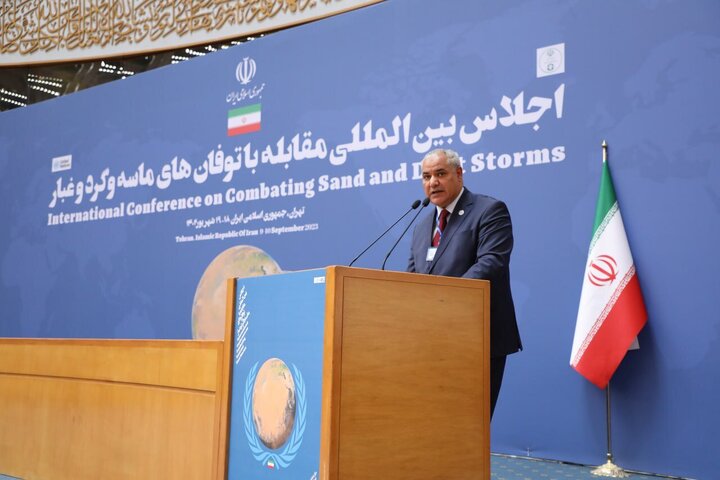Iran (IMNA) - These storms affect more than 150 countries worldwide and pose significant risks to human health, food security, transportation, energy, and the environment. Elwaer addressed these concerns at the International Conference on Combating Sand and Dust Storms in Tehran, which was organized by the Iranian Department of Environment with the support of the United Nations.
During his speech, Elwaer highlighted the transboundary nature of SDSs and the economic losses they can cause, reaching hundreds of millions of dollars from a single event. He also emphasized the role of climate change in exacerbating SDS hazards, leading to drought and the degradation of vegetation cover. This has a disproportionate impact on farmers and communities dependent on natural resources, making it crucial to develop sustainable practices and policies.
To address these challenges, the United Nations Coalition on Combating Sand and Dust Storms was established in 2019, consisting of 19 UN agencies and non-UN organizations, currently chaired by FAO. The Coalition's mandate is to promote knowledge exchange, dialogue, capacity building, and global action against SDS.
Elwaer stressed the importance of implementing the Coalition's strategy and action plan to mobilize political will and resources, as well as strengthen international cooperation. He called for collaborative efforts to mitigate the sources and reduce the impact of SDS on people, societies, and economies. He expressed hope for the success of the conference and reaffirmed FAO's commitment to fostering cooperation among Coalition members and countries. He concluded by stating that FAO and the United Nations Coalition are ready to support countries in their efforts to combat SDS and minimize its effects on various sectors.
Sand and dust storms in Iran
Sand and dust storms have become a recurring environmental phenomenon that poses significant challenges to countries across the globe. Among the countries most affected by these storms, Iran stands out as one grappling with the adverse effects of sand and dust storms on its environment, economy, and public health. This article aims to shed light on the detrimental consequences of sand and dust storms in Iran and the urgent need for effective measures to mitigate their impact.
Environmental Degradation
Sand and dust storms contribute to severe environmental degradation in Iran. These storms carry vast amounts of fine particles, such as sand and dust, which can travel hundreds of kilometers, leading to the erosion of fertile soil, loss of vegetation cover, and desertification. The resulting degradation of ecosystems not only disrupts the delicate balance of nature but also threatens biodiversity and reduces agricultural productivity.
Economic Implications
The economic implications of sand and dust storms in Iran are far-reaching. The agricultural sector, which plays a vital role in Iran's economy, suffers immensely due to reduced crop yields caused by the deposition of dust and sand on plants. The storms also damage infrastructure, including buildings, roads, and power lines, leading to substantial repair and maintenance costs. Additionally, sand and dust storms hamper tourism, affecting revenue generation and employment opportunities in the affected regions.
Health Hazards
One of the most concerning aspects of sand and dust storms in Iran is their impact on public health. Fine particles carried by these storms can penetrate deep into the respiratory system, causing or exacerbating respiratory diseases such as asthma, bronchitis, and allergies. The increased presence of airborne pollutants also contributes to air pollution, which poses significant health risks for the population, particularly vulnerable groups such as children, elderly individuals, and those with pre-existing respiratory conditions.
Climate Change Amplifier
Sand and dust storms have been recognized as a climate change amplifier, exacerbating the effects of global warming. The accumulation of dust and sand particles in the atmosphere reduces sunlight reaching the Earth's surface, leading to decreased solar radiation and altered weather patterns. This phenomenon contributes to changes in temperature, precipitation patterns, and wind dynamics, further aggravating the challenges posed by climate change in Iran.


Your Comment